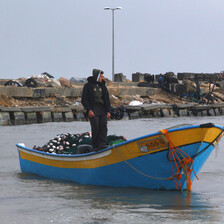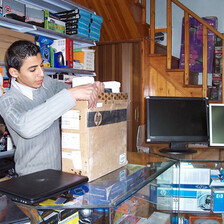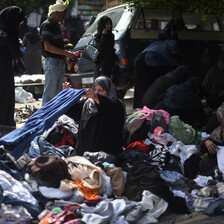The Electronic Intifada 31 August 2009
GAZA CITY, occupied Gaza Strip (IPS) - Abu Abed can’t make a profit, and although 54 years old, he still has not married. “I can’t pay my rent, I can’t afford a wedding.”
His shop, roughly 3 meters by 4 meters, costs him more than $3,500 a year in rent alone.
His wares are laid out on tables on a busy pedestrian street in the Saha market area in Gaza City. The goods, plastic toys and running shoes imported from China, were brought in via the tunnels between Gaza and Egypt, at a high price.
One large bag of grain filled with the cheaply made toys cost $30 to purchase, but the tunnel trip added another $70 to Abu Abed’s expenditures. “I can make maybe $20 when I sell these toys, but that will take two or three months.”
Now that the month of Ramadan is under way, festive decorations and toys are among his stock. Yet with unemployment in Gaza hovering near 50 percent, and searing poverty at 80 percent, few can afford the luxury of such items, at now grossly inflated prices.
“That toy is 20 shekels,” Abed says pointing to a plastic toy. “It should only cost maybe five or six shekels. People don’t want to buy it.” But if Abu Abed wants to break even, he cannot sell the toy for less than 20 shekels.
For Ghazi Attab, a fruit vendor in Saha market, regular crossing procedures couldn’t come quickly enough. He estimates that 30 percent of his produce is spoiled due to long hours in the sun waiting for Israeli clearance to enter Gaza.
“The Israelis don’t allow the fruit to enter Gaza right away. It sits at the crossings for five or six hours under the sun,” he said, pointing to a box of rotted mangos.
Hazem, father of four, has a store in a different region of Saha. The shelves are stocked with shampoo, hair and skin creams, cosmetics, toothpaste, cleaning products and other everyday items. All of his stock was brought through the tunnels, at a high price.
Before the Israeli siege on Gaza, Hazem used to import goods via Israeli crossings.
“I’d buy goods coming from China, and when they arrived at Ashdod, it would take just another week for them to be checked and to enter Gaza.”
After Hamas took power in Gaza in June 2007, following its election victory in early 2006, there was a noticeable delay in the arrival of imported goods.
“Suddenly it was taking two months for imports to enter Gaza,” Hazem said. From two-month delays it came to entering only around Ramadan, to not entering at all.”
Aside from losing a direct route of importing, Hazem has more than $80,000 at stake.
“When I bought goods from China in October 2008, the items weren’t forbidden,” he says, referring to the Israeli-imposed restrictions on what can enter Gaza. According to a report in the Israeli daily Haaretz in May 2009, only 30 to 40 items are being allowed into Gaza.
The majority of items on Hazem’s list are banned. Two containers full of these items sit in a storage facility in Ashdod, for which he has had to pay $550 per month since October 2008.
Among the items are underwear, socks, caps, gloves, belts, perfumes, toothpicks, toothbrushes, scarves.
“We have to pay import tax to Israel. I paid $1,468 on my goods, plus paid for the actual goods themselves.” That is in addition to storage charges for the containers.
“But I can’t send the stuff back to China,” he adds. He pays the rent, he says, in hope of importing the goods one day and digging himself out of debt.
According to the Palestinian Chamber of Commerce in Gaza, there are currently over 1,700 containers of imported goods ordered by Gaza merchants being stored in Israel and the West Bank until they are allowed into Gaza. A breakdown of the items listed by the Chamber of Commerce includes clothing, shoes, electronics and toys.
Over half of the containers have been held in storage since 2007. The Chamber of Commerce reports direct losses of an estimated 10 million dollars, including storage and handling costs, and indirect losses in losing contracts and ties with outside suppliers.
On 23 August, the new school year began for nearly 450,000 school children in Gaza. Many of these children will attend classes unprepared, as notebooks and other items needed for school have not been allowed into Gaza. Nor has the construction material needed to repair the many schools damaged by Israeli shelling and bombing during Israel’s three-week assault on Gaza last December-January.
Currently, the Karem Abu Salem (Kerem Shalom) crossing is the only entrance point for commercial goods after the better equipped and larger Karni crossing was closed by Israeli authorities. Karem Abu Salem does not operate at full capacity, and there are long delays in inspection of Gaza-bound goods.
A report this month by the United Nations Office for Coordination of Humanitarian Affairs (OCHA) notes that during the first five months of 2007, an average of 583 trucks entered Gaza per day. Now, the daily average is 112, of which 70 percent are food products.
OCHA further notes that “95 percent of the industrial establishments, or 3,750 establishments, were forced to shut down, and the remaining five percent were forced to reduce their level of activity.”
With crossings closed or barely functioning, most of Gaza’s goods are brought in at steep prices via the tunnels. Last week Egyptian authorities announced a seizure of such goods bound for Gaza before the start of Ramadan. Among the millions of dollars worth of goods seized were wood, glass, electronic equipment and appliances, tires, carpets, and large quantities of sweets, nuts and foodstuffs used during Ramadan.
All rights reserved, IPS — Inter Press Service (2009). Total or partial publication, retransmission or sale forbidden.





